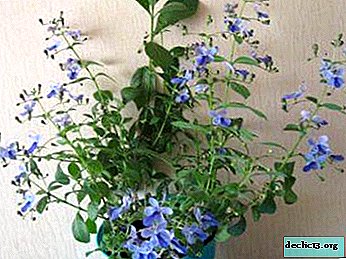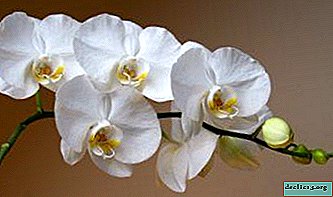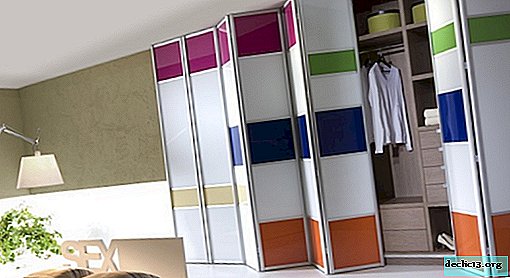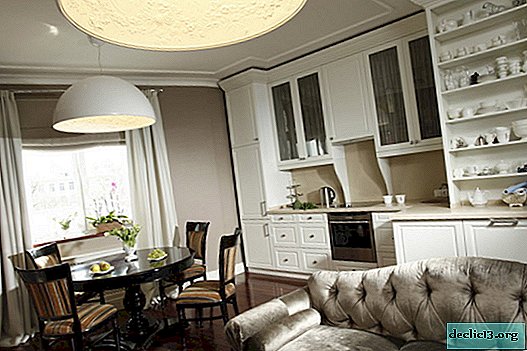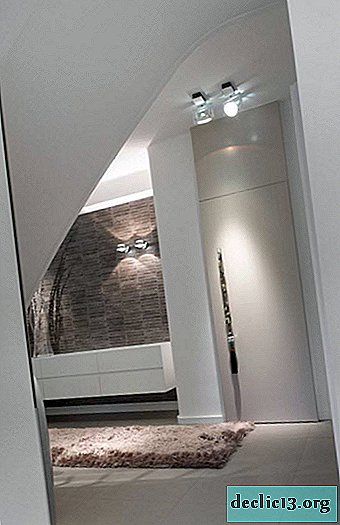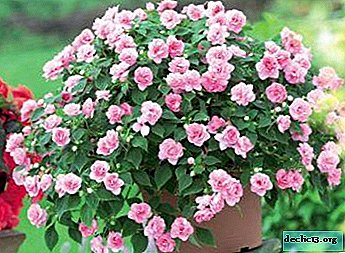A flowering houseplant is a cactus hymnocalicium. Description of its species - Rubra, Anicitsi and others
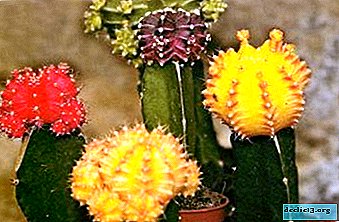 If you are a lover of cacti, then a hymnocalycium should definitely appear in your collection. Why? It cannot be otherwise! After all, this flowering handsome is as unpretentious as it is popular, and has a lot of varieties for every taste and color.
If you are a lover of cacti, then a hymnocalycium should definitely appear in your collection. Why? It cannot be otherwise! After all, this flowering handsome is as unpretentious as it is popular, and has a lot of varieties for every taste and color.
In our article we will talk about the varieties of this succulent and consider their features and differences. You can also watch a useful video on this topic.
Popular types and varieties of houseplants of the hymnocalicium
Anisitsii (Anisitsii)

Elegant, miniature succulent Anizitsi. Flowers are milky white, 4-5 cm in diameter. The stem is spherical, has 11 ribs, divided into tubercles. Each tubercle is crowned with a bunch of thorns sticking out in different directions. They are curved, of different sizes. The stem can grow up to 8 centimeters.
We recommend watching the video about the flowering of the Anitsitsi hymnocalycium:
Rubra

One of the most common among flower growers, despite the fact that it blooms less often than others and quickly grows old. Very elegant plant even outside the flowering period. Often used in decorative phytocompositions. It reaches 6 cm in diameter. The shades of the stem are varied: from cherry to bright scarlet. Ribs low, with transverse wrinkles. The mother plant grows a lot of "babies" that renew the plant.
Horst (Horstii)

It was found by the famous German explorer of cactus flora Leopold Horst in in southern Brazil. It grows on the steep mountain slopes, on flat rocks protected from the scorching sun. It has a flattened shape and a height of 20-25 cm. The cactus is dark green in color, blooms in large (up to 10 cm) flowers.
Shades of petals are diverse:
- pink;
- cream;
- lilac;
- white.
Cactus requires high temperature and clay loamy soil. The temperature suitable for wintering is + 12-15 degrees with light humidity, if the conditions are violated, it quickly withers. In the summer it requires abundant watering, thanks to the excess of moisture it becomes stone-hard.
Bodenbenderianum

It has a flat, disc-shaped stalk, barely rising above the ground, gray-green or brown in color, 2-3 cm high, up to 8 in diameter. The ribs are round, clearly tuberous, low. The thorns are curved towards the stem, strong, dark brown in the young plant, turn gray with age. Quantity - 3-7 pieces, up to 1 cm long. Fruits up to 3 cm long, blue-green, ovoid. There are 2 subspecies: one grows in Northern Argentina, the second in Cordoba and La Rioja.
Bruch (Bruchii)

Widely distributed in Argentina, is a favorite treat of goats. It has a miniature stem, abundantly branches. There are about 10 radial spines, they are white and thin. Located in the center - white or brown, 3 pieces. Succulent propagates easily by side shoots. It has 3 subspecies and 3 varieties.
Friedrich (Friedrichiae)

These cacti have the least chlorophyll. Primary colors are burgundy-lilac and red-brown.
Attention: The world famous green and red cacti were bred from Frederick.Ahirasense (Achirasense)

It has a spherical or squeezed-spherical stem, dull green in color with an olive shade, up to 8 cm high and 5 cm in diameter. Areoles in the white-gray fringe. Ribs from 12 to 15 pieces, divided into tubercles. Spines from 6 to 12, they are curved to the stem, awl-shaped, rigid, covered with tiny scales.
Color - gray or yellow, the tips are dark. The central spine on some specimens may not be. The flowers are light pink in color, diameters up to 7 cm, dark stripes are present on the petals. Fruits are spindle-shaped, dark green.
Monvillei

This species has a spherical stem with a depressed apex. Gray-green color with a brilliant shade. Ribs in the amount of 13-17 pieces, tubercles rounded. Spines bent to the stem. They can be from 7 to 13, various shades of yellow, up to 4 cm long. Flowers reach 8 cm in diameter, white or pink.
Spegazzini (Spegazzinii)

Also called Gymnocalycium armatum. Under natural conditions it grows in large spaces stretching for 300 km from north to south. Very beautiful and volatile instance. The stems are single, brown or green, with a diameter of 18 cm and a height of 20-22. Ribs are low, their number varies from 10 to 15.
The flowers are pale pink or white with a red center. On the outside of the petals, a faint greenish strip. The fruits are green, cylindrical in shape. Seeds are tiny (1 mm), brown-black). It grows well both in the sun and in the shade.
Important: It is necessary to monitor the roots - they often rot.Pflanzii

The habitat is Argentina and Bolivia. Single plants with spherical fruits of raspberry color. The stem is olive in color with a faint pink tint, spherical, slightly flattened. It grows to 6-8 cm in height, diameter - 15 cm or more. Areolae oval, large, rounded ribs, in the amount of 8-10. The spine in the center is short. Radial spines are very stiff and strong, bent to the stem, white or pinkish in color, with brown ends. Tubes of flowers are short, salmon-colored, up to 5 cm in diameter.
Intertextum

Homeland - the north of Argentina. The smallest and most unpretentious cactus. It has 5-7 spines and 13-16 rounded ribs with clearly defined tubercles. To grow, you need good lighting, waterproof, well-drained substrate. For wintering, the room temperature drops to 8-10 degrees.
Platygonum (Platygonum)

The stem is brown-brown in color, the ribs of the young plant are green. The needles are yellow, dull, hard, growing in different directions. The tubercles on the ribs are small, sharply protruding.
Ambatoense

The stem is dark green, matte, with a flattened tip. Ribs from 9 to 17, one central spine, sometimes absent. Radial - yellowish brown, turn pink with age. Awl-shaped, strong, grow in pairs, part upward. The flowers are white with pink strokes on the petals. Fruits are dark green, flattened. Areoles are covered with a grayish fluff. Seeds are red-brown, about 1 mm long.
Ragonesii

The smallest of the existing varieties. The plant is gray-green or pale brown. The stem is up to 5 cm in diameter and barely rises above the surface of the soil. Ribs flat, transverse grooves poorly marked. Spines 5-6, they are very thin and whitish. Fusiform or ovoid fruits, up to 3 cm in length. It begins to bloom, reaching a diameter of 2 cm.
Damsa (Damsii)

Widespread view. The stem is flat, spherical, lengthens with age and begins to branch at the base. Ribs 11, radial spines - 5-7. The flowers are large, white with a pink tint. The fruits are red, cylindrical, up to 2.5 cm in length. For this plant, a bright, but protected from sunlight, is best suited. On warm days it is advisable to take it out into the air.
Kvela (Quehlianum)

Another of the most unpretentious, but slowly growing species. The trunk is greenish, the ribs are barely visible, the spikes are weakly expressed. Spines are whitish, small in number. The flowers are white, with a diameter of up to 6 cm. Not suitable for home cultivation instance.
Prozazkianum (Prochazkianum)

It has a gray-green and very large stem, and no less massive root. It is covered with a gray coating. There are no central thorns, the ranges are white and fluffy, but darken over time. The outer part of the petals is cream in a green stripe in the center, the inside is white with red. Anthers dark pink, white stamens. Succulents prefers loamy soil.
Andre (Andreae)

In the wild, this cactus grows alone, while in culture it forms groups 15 and more cm wide. One of the most frost-resistant cacti, can withstand temperatures up to -15 degrees. It transfers both bright lighting and shading. It is prone to decay, so waterlogging of the soil is unacceptable. In summer, it is necessary to feed with high potassium fertilizers. He does not like limestone-rich substrates.
The stem is spherical, the apex is depressed, can be bluish-green or black-green in color with a bronze tint. The root system is rod, large. Ribs 8-13 pieces, no protrusions on them, only thin intersecting grooves. Spines less than 1.5 cm, maximum 13 pieces. Radial thin, grow horizontally. Central 1 (rarely 3), thin, stiff, brown in color, with a curved ridge.
The flowers are bright lemon, with many pointed petals. With a short tube or without it at all. Anthers are yellow, on the outer segments of the perianth are juicy green touches. Seeds are black, matte. Fruits can be either cylindrical or spherical in shape. Some varieties of cacus emit a sweetish aroma..
Humpback (Gibbosum)

There are two varieties. The first - nigrum - is rare, has a black-green stem and black spines. The second is more common. Its stem is green with a bluish tint, spherical in youth, becomes cylindrical with age. Height - up to 50 cm, diameter - 18-20. The ribs are divided by transverse recesses into segments. Areoles have a grayish pubescence. Radial spines are most often 10, their length is 1-2 cm. The central spine is one, with a red base and a curved tip.
Salion (Saglionis)

The stalk is fleshy, round, with a diameter of up to 30 cm. Covered with flat tubercles and black spines. The spikes are arched. The flowers are bell-shaped, white and pinkish. It blooms from May to November. Rosettes of thorns easily come off in a young plant, therefore it requires extreme accuracy. Easily propagated by seeds. With excessive watering, the roots quickly rot. It does not tolerate direct sunlight.
Nude (Denudatum)

Suitable for growing both indoors and in greenhouses. The maximum size is 10 cm in diameter. Funnel-shaped flowers, diameter - 6 cm, narrow and numerous petals, bend outward, white, very rarely pink. It blooms from May to September. The tubercles on the stem are flattened, as are the ribs. There are few thorns, they fit snugly on the stem and look spectacular due to the wavy shape. Central spines are absent altogether.
We talked about the specific features of the nude hymnocalicium and the tips for caring for it in a separate article.
Balda (Baldianum)

A distinctive feature of this plant is the spikes protruding to the sides, long and light.. The stem is gray-green, spherical, with triangular ribs. Height - 7-9 cm. Petals of buds of a very beautiful shape.
You can learn more about Bald’s unpretentious hymnocalicium here.
Japanese (Facilisis)

The hybrid form of the variety "Friedrich", having a brightly colored stem. Such cacti are not viable on their own, but grow if they plant a suitable stock. Breeders managed to bring out cacti of various colors:
- maroon;
- pink;
- brown;
- orange.
Read more about the bizarre Japanese hymnocalicium and the rules for growing it here.
Mix

If you want to create a bright and original composition, put several varieties of mix hymnaliciums in one container. Miniature specimens should be selected (no more than 5 cm in diameter each).
Florists say that a cactus like a sponge absorbs radiation from electromagnetic devices and even the negative emotions of other people.
Conclusion
If you have never cultivated cacti, now is the best time! And it’s best to start with the hymnocalycium. It is ideal for beginners and will bloom, even if you give it a minimum of attention.




